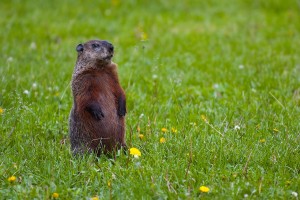 Groundhog Day (Canadian French: Jour de la Marmotte; Pennsylvania German: Grundsaudaag, Murmeltiertag) is a day celebrated on February 2. According to folklore, if it is cloudy when a groundhog emerges from its burrow on this day, then spring will come early; if it is sunny, the groundhog will supposedly see its shadow and retreat back into its burrow, and the winter weather will persist for six more weeks.
Groundhog Day (Canadian French: Jour de la Marmotte; Pennsylvania German: Grundsaudaag, Murmeltiertag) is a day celebrated on February 2. According to folklore, if it is cloudy when a groundhog emerges from its burrow on this day, then spring will come early; if it is sunny, the groundhog will supposedly see its shadow and retreat back into its burrow, and the winter weather will persist for six more weeks.
Modern customs of the holiday involve celebrations where early morning festivals are held to watch the groundhog emerging from its burrow.
In southeastern Pennsylvania, Groundhog Lodges (Grundsow Lodges) celebrate the holiday with fersommlinge, social events in which food is served, speeches are made, and one or more g’spiel (plays or skits) are performed for entertainment. The Pennsylvania German dialect is the only language spoken at the event, and those who speak English pay a penalty, usually in the form of a nickel, dime, or quarter per word spoken, with the money put into a bowl in the center of the table.
The largest Groundhog Day celebration is held in Punxsutawney, Pennsylvania, with Punxsutawney Phil. Groundhog Day, already a widely recognized and popular tradition, received widespread attention as a result of the 1993 film Groundhog Day.
History:
The celebration, which began as a Pennsylvania German custom in southeastern and central Pennsylvania in the 18th and 19th centuries, has its origins in ancient European weather lore, wherein a badger or sacred bear is the prognosticator as opposed to a groundhog. It also bears similarities to the Pagan festival of Imbolc (the seasonal turning point of the Celtic calendar, which is celebrated on February 1 and also involves weather prognostication) and to St. Swithun’s Day in July 15.
Historical Origins:
The first documented American reference to Groundhog Day can be found in a diary entry, dated February 4, 1841, of Morgantown, Pennsylvania, storekeeper James Morris:
Last Tuesday, the 2nd, was Candlemas day, the day on which, according to the Germans, the Groundhog peeps out of his winter quarters and if he sees his shadow he pops back for another six weeks nap, but if the day be cloudy he remains out, as the weather is to be moderate.
In Scotland, The Poem:
If Candle-mas Day is bright and clear,
There’ll be two winters in the year.If Candle mas be fair and bright,
Winter has another flight.
If Candlemas brings clouds and rain,
Winter will not come again.
Alternative Origin Theories:
In western countries in the Northern Hemisphere, the official first day of spring is almost seven weeks (46–48 days) after Groundhog Day, on March 20 or March 21. The custom could have been a folk embodiment of the confusion created by the collision of two calendrical systems. Some ancient traditions marked the change of season at cross-quarter days such as Imbolc when daylight first makes significant progress against the night. Other traditions held that spring did not begin until the length of daylight overtook night at the Vernal Equinox. So an arbiter, the groundhog/hedgehog, was incorporated as a yearly custom to settle the two traditions. Sometimes spring begins at Imbolc, and sometimes winter lasts six more weeks until the equinox.
Locations:
The largest Groundhog Day celebration is held in Punxsutawney, Pennsylvania, where crowds as large as 40,000 have gathered to celebrate the holiday since at least 1886. Other celebrations of note in Pennsylvania take place in Quarryville in Lancaster County, the Anthracite Region of Schuylkill County, the Sinnamahoning Valley and Bucks County.
The day is observed with various ceremonies at other communities in North America,including in Wiarton, Ontario, at the Shubenacadie Wildlife Park in Nova Scotia, and at the University of Dallas in Irving, Texas (which has what is claimed to be the second largest Groundhog celebration in the world).
Did you know that if you subscribe to our website, you will receive email notifications whenever content changes or new content is added.
1. Enter your e-mail address below and click the Sign Me Up button.
2. You will receive an email asking you to confirm your intention of subscribing to our site.
3. Click the link in the email to confirm. That’s all there is to it! Note: if you wish to unsubscribe from our site, click the unsubscribe link at the bottom of the email you received.
Then indicate you no longer wish to receive our emails.
Thank You
Dialect Zone International